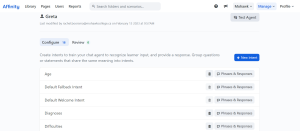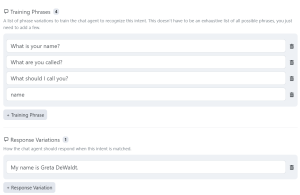Affinity Learning
What is Affinity Learning?
Affinity Learning is an online web tool that allows us to create interactive learning scenarios. Key features of Affinity Learning:
- Interactive Learning Experiences- Provide learners with an opportunity to practice their knowledge acquisition, application, and decision-making in a simulated, web-based environment.
- Intuitive Authoring- Rapidly build learning scenarios using interaction-types that best fit your specific learning objectives.
- Mobile-Friendly- All scenarios in Affinity are fully accessible on mobile and touch devices. Learners can access Affinity using their phones, tablets, or computers, without needing to install any software.
- Visual Interactions- Choose from Affinity’s list of intuitive, visual interaction types for your scenario, based on your specific learning objectives. Make your existing educational content interactive by integrating images, videos, and audio recordings into scenarios.
- 360° Media Support- Upload a photo or video of a room or scene taken with your 360-degree camera. Use hotspots to allow learners to explore their surroundings, and the objects inside it.
- Decision-making Opportunities- Allow learners to test their decision making skills and control the outcome of a simulated scenario. Create divergent learning pathways using decision branching.
- Branching- Modules can incorporate multiple learning paths, based on the learner’s decisions. Each decision can be configured to take the learner down a unique learning path.
- Knowledge Inquiries- Allow learners to self-evaluate their understanding of key concepts using inquiries with real-time feedback.
- Scoring & Evaluation- All interactions are captured and stored. Scoring can be applied to each inquiry to evaluate learner performance and identify knowledge gaps.
- LMS Integration- Provide learners with one-click access to Affinity scenarios directly through their LMS accounts. Easily integrate Affinity with any LMS platform that supports the LTI standard, like D2L Brightspace or Canvas.
- Score & Results Sync- Optionally sync completion status, scores, and learner results breakdowns with your organization’s LMS. Allow learners to download their results as a PDF when they complete a scenario.
- Intuitive Authoring- Rapidly develop learning modules that incorporate interactive elements like decision branching, multiple choice questions, and text evaluations. Easily include your existing educational materials like images, videos, or audio files within scenarios.
Demo of Affinity Learning
Video-Based Branching Simulations
What are Video-Based Branching Simulations?
Video-based branching simulations are interactive learning experiences that use video content to present scenarios where learners can make choices that affect the outcome. These simulations typically mimic real-life situations, allowing learners to practice decision-making and see the consequences of their actions in a safe, controlled environment.
Key Features
- Interactive Decision Points: Videos are interspersed with decision points where learners must choose from multiple options. Each choice leads to a different video segment, creating a branching narrative.
- Realistic Scenarios: Videos often depict real-life situations relevant to the training context, making the experience more immersive and practical.
- Feedback and Consequences: Immediate feedback is provided based on the learner’s choices, showing the consequences of their decisions. This helps in reinforcing learning objectives.
- Multiple Paths and Outcomes: Different choices lead to various paths and endings, providing a comprehensive learning experience with multiple outcomes.
Delivery
Provide learners with one-click access to Affinity scenarios directly through their MyCanvas account or share with a link.
Reporting
Optionally sync completion status, scores, and learner results breakdowns with your organization’s LMS. Allow learners to download their results as a PDF when they complete a scenario.
Considerations
Video simulations are complex assets that can take weeks to months to develop. The process involves:
- Storyboarding and scripting
- Finding and coordinating actors
- Filming
- Editing
- Building the simulation in Affinity Learning
- Final reviews and edits
- Integration in LMS
For resources on developing a simulation, check out Appendix A.
Examples
Below are examples of content that can be added to a simulation in Affinity Learning:
AI Chatbots
What are AI Chatbots?
An AI chatbot is a software application that uses artificial intelligence to simulate human conversation, allowing users to interact with it via text or voice. It can answer questions and provide information. Chatbots can be programmed by the RRT and Subject Matter Experts, and can be improved upon after every cohort; The chatbot keeps a record of all questions asked by the learners and identifies which questions it does not have a response for, so you can build in new responses for the next time.
Considerations
AI chatbots need to be requested from Affinity Learning by the RRT. Faculty that want to use a chatbot in their course must consider potential ways learners may ask questions and provide different response options for the chatbot based on the question asked.
Example
To check out a demo of an AI Chatbot, click here.
See the images below for an example of how a Chatbot is programmed.


